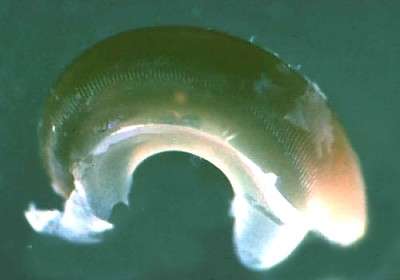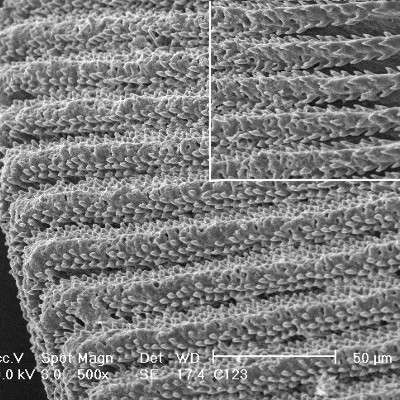Atys naucum gizzard plates
December 23, 1999
From: C. Carlson & P.J. Hoff


Bill,
Here is a Xmas gift you might enjoy -- & which we assume you don't have already.
UPPER PHOTO: Atys naucum [shell 22mm], gizzard plate; Palau, Ngderrak reef flat; 27 May 1996; leg. Gustav Paulay.
LOWER PHOTO: SEM scan of gizzard plate. [Inset showing rodlets in central region of plate] by Heather Winsor, James Cook University, Townsville, Queensland.
The quality of the photo through the dissecting scope isn't very good, but does give an accurate view of the shape of the plate. Usually when the gizzard plates end up on an SEM stub they are warped out of shape, though the scan can give a descriptive view of what is happening with the ridges and 'rods'.
Through the dissecting scope the gizzard plates of A. naucum appear almost smooth except for the very fine ridging. The SEM showing the 'rods' was a surprise. The contrast in the nature of the gizzard plates between A. naucum and A. cylindricum (as well as a number of other characters) adds support to Pilsbry's Aliculastrum as a separate genus [originally as a subgenus] for A. cylindricum - like animals.
Have a good holiday season!
Clay & Patty Jo
Merizo, Guam
clay.carlson@kuentos.guam.net
Carlson, C. & Hoff, P.J., 1999 (Dec 23) Atys naucum gizzard plates. [Message in] Sea Slug Forum. Australian Museum, Sydney. Available from http://www.seaslugforum.net/find/1704Dear Clay & Patty Jo,
The bubble shells I posted last Xmas were such a success amongst shell-collectors that I am glad you've kept the 'tradition' alive this year with Atys naucum.
The shape of the gizzard plates of Atys naucum are indeed very interesting being quite different from the heavily ridged ones of Atys cylindrica which are very similar to those found in species of Haminoea. The finely grooved plates of Atys naucum are identical to those of Smaragdinella calyculata and Phanerophthalmus smaragdinus (see Rudman, 1972). At that time I suggested the gizzard plate structure was sufficient to place Phanerophthalmus and Smaragdinella in the family Smaragdinellidae to distinguish them from the Haminoeidae (Atyidae). It now seems that the split between these related groups occurred amongst the more primitive large-shelled species. I agree that Aliculastrum may indeed be an appropriate genus distinct from Atys.
I have posted the only photo I have of a Haminoea gizzard plate as a separate message.
Best wishes,
Bill Rudman
Reference: Rudman,W.B. (1972) The herbivorous opisthobranch genera Phanerophthalmus A.Adams and Smaragdinella A.Adams. Journal of Natural History, 5: 647-675.
Rudman, W.B., 1999 (Dec 23). Comment on Atys naucum gizzard plates by C. Carlson & P.J. Hoff. [Message in] Sea Slug Forum. Australian Museum, Sydney. Available from http://www.seaslugforum.net/find/1704Related messages
-
Atys ehrenbergi from the Red Sea
From: Binyamin Koretz, May 4, 2005 -
Juvenile Atys naucum from the Philippines
From: Erwin Koehler, March 27, 2002 -
Atys from Sulawesi
From: Lindsay Warren, January 26, 2001 -
Erwin's Atys sp. is Atys naucum
From: Terry Gosliner, January 20, 1999 -
Atys?, Haminoea? from Red Sea
From: Erwin Koehler, January 19, 1999
